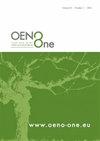Different effectiveness of protein fining agents when tested for interaction and precipitation with tannic acid, a seed polyphenol extract and seven wines
IF 2.2
3区 农林科学
Q3 FOOD SCIENCE & TECHNOLOGY
引用次数: 0
Abstract
Wine fining comprises any operation resulting in the cleaning, stabilisation and improvement of the organoleptic characteristics of wine. Fining agents, such as certain proteins of varying electrical charges, interact physicochemically with wine polyphenols in ways not yet fully understood with diverse effects on wine attributes. In this study, four widely used protein fining agents (casein, ovalbumin and two gelatins) were compared for their ability to interact with three different types of phenolic-rich solutions: a tannic acid solution, a wine grape seed extract and seven different varietal wines. A phenolic characterisation of both the seed extract and all the wines was carried out. The interaction between the protein fining agents and the phenolic solutions was evaluated by diffusion and precipitation tests on cellulose membranes and protein staining. All four protein fining agents interacted to differing extents by producing soluble and insoluble complexes with the tannic acid, grape seed extract and wines. In the wines, the interactions were found to not only depend highly on the protein composition of the fining agent, but also on the chemical composition of the wine. Notwithstanding, the observed phenolic differences between the wines could not fully account for the differential interactions between wine and the fining agents, thus indicating that the wine matrix as a whole may play a role in those interactions.蛋白质精化剂与单宁酸、一种种子多酚提取物和7种葡萄酒的相互作用和沉淀效果不同
葡萄酒精制包括导致葡萄酒的清洁,稳定和改善感官特性的任何操作。细化剂,如某些不同电荷的蛋白质,与葡萄酒多酚发生物理化学相互作用,其方式尚未完全了解,对葡萄酒属性有不同的影响。在这项研究中,比较了四种广泛使用的蛋白质精化剂(酪蛋白、卵清蛋白和两种明胶)与三种不同类型的富含酚的溶液(单宁酸溶液、葡萄酒葡萄籽提取物和七种不同品种的葡萄酒)的相互作用能力。对种子提取物和所有葡萄酒进行了酚性表征。通过纤维素膜上的扩散和沉淀试验和蛋白质染色来评价蛋白质精化剂与酚溶液的相互作用。所有四种蛋白质精化剂通过与单宁酸、葡萄籽提取物和葡萄酒产生可溶性和不溶性配合物而在不同程度上相互作用。在葡萄酒中,发现这种相互作用不仅高度依赖于细化剂的蛋白质组成,而且还取决于葡萄酒的化学组成。尽管如此,所观察到的葡萄酒之间的酚类差异并不能完全解释葡萄酒与精制剂之间的不同相互作用,因此表明葡萄酒基质作为一个整体可能在这些相互作用中起作用。
本文章由计算机程序翻译,如有差异,请以英文原文为准。
求助全文
约1分钟内获得全文
求助全文
来源期刊

OENO One
Agricultural and Biological Sciences-Food Science
CiteScore
4.40
自引率
13.80%
发文量
85
审稿时长
13 weeks
期刊介绍:
OENO One is a peer-reviewed journal that publishes original research, reviews, mini-reviews, short communications, perspectives and spotlights in the areas of viticulture, grapevine physiology, genomics and genetics, oenology, winemaking technology and processes, wine chemistry and quality, analytical chemistry, microbiology, sensory and consumer sciences, safety and health. OENO One belongs to the International Viticulture and Enology Society - IVES, an academic association dedicated to viticulture and enology.
 求助内容:
求助内容: 应助结果提醒方式:
应助结果提醒方式:


